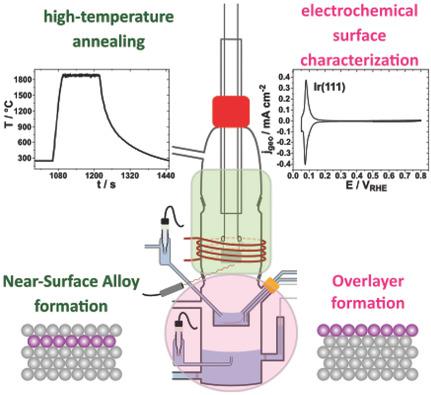当前位置:
X-MOL 学术
›
Small Methods
›
论文详情
Our official English website, www.x-mol.net, welcomes your
feedback! (Note: you will need to create a separate account there.)
Coupled Inductive Annealing‐Electrochemical Setup for Controlled Preparation and Characterization of Alloy Crystal Surface Electrodes
Small Methods ( IF 10.7 ) Pub Date : 2018-08-16 , DOI: 10.1002/smtd.201800232 Ebru Özer 1 , Benjamin Paul 1 , Camillo Spöri 1 , Peter Strasser 1, 2
Small Methods ( IF 10.7 ) Pub Date : 2018-08-16 , DOI: 10.1002/smtd.201800232 Ebru Özer 1 , Benjamin Paul 1 , Camillo Spöri 1 , Peter Strasser 1, 2
Affiliation

|
The present versatile multifunctional electrochemical crystal preparation‐test station features capabilities for controlled thermal annealing of any type of (binary) metallic or oxidic catalyst or support crystal surfaces, in particular single crystals. The setup enables rapid inductive heating of the electrodes to temperatures up to 1900 °C under precise infrared temperature control in controlled gas atmospheres. The constant overpressure inside the cell prevents the ambient atmosphere to permeate and contaminate the process. Finely adjusted sensors afford accurate and instant information on the electrodes' surface temperature. The subsequent cooling process in argon atmosphere proceeds without any treatment in water. After annealing, the crystals inside the chamber can immediately be subjected to any type of electrochemical deposition, modification, or characterization in two distinct three‐electrode chambers, again without any exposure to air. Both chambers feature pump‐controlled supply and withdrawal of liquid electrolyte. A special characteristic is the inert‐gas flow inversion capability to transfer electrodes into separate portable inert‐gas chambers. Design details are presented and their functionality during thermal preparation and electrochemical voltammetry of Ir(111) catalysts for the oxygen evolution reaction are demonstrated. The station provides a crystal handling environment superior to the classic flame annealing approaches, yet to constitute a cost‐effective alternative to vacuum chambers.
中文翻译:

耦合感应退火-电化学装置可控制地制备和表征合金晶体表面电极
目前多功能的多功能电化学晶体制备测试站具有对任何类型的(二元)金属或氧化催化剂或载体晶体表面(特别是单晶)进行受控热退火的功能。该设置可在受控的气体气氛中,在精确的红外温度控制下,将电极快速感应加热到高达1900°C的温度。电池内部恒定的超压可防止周围大气渗透和污染过程。精细调整的传感器可提供有关电极表面温度的准确且即时的信息。氩气中的后续冷却过程无需在水中进行任何处理即可继续进行。退火后,腔室内的晶体可以立即进行任何类型的电化学沉积,修改,或在两个不同的三电极腔室中进行表征,同样,也不要暴露在空气中。两个腔室均具有泵控制的液体电解质供给和抽取功能。惰性气体流转化功能的特殊之处在于可以将电极转移到单独的便携式惰性气体腔室中。提出了设计细节,并证明了其在热制备和Ir(111)催化剂中用于氧释放反应的电化学伏安分析中的功能。该工作站提供了优于经典火焰退火方法的晶体处理环境,但仍构成了真空室的经济高效替代方案。两个腔室均具有泵控制的液体电解质供给和抽取功能。惰性气体流转化功能的特殊之处在于可以将电极转移到单独的便携式惰性气体腔室中。提出了设计细节,并证明了其在热制备和Ir(111)催化剂中用于氧释放反应的电化学伏安分析中的功能。该工作站提供了优于经典火焰退火方法的晶体处理环境,但仍构成了真空室的经济高效替代方案。两个腔室均具有泵控制的液体电解质供给和抽取功能。惰性气体流转化功能的特殊之处在于可以将电极转移到单独的便携式惰性气体腔室中。提出了设计细节,并证明了其在热制备和Ir(111)催化剂中用于氧释放反应的电化学伏安分析中的功能。该工作站提供了优于经典火焰退火方法的晶体处理环境,但仍构成了真空室的经济高效替代方案。提出了设计细节,并证明了其在热制备和Ir(111)催化剂中用于氧释放反应的电化学伏安分析中的功能。该工作站提供了优于经典火焰退火方法的晶体处理环境,但仍构成了真空室的经济高效替代方案。提出了设计细节,并证明了其在热制备和Ir(111)催化剂中用于氧释放反应的电化学伏安分析中的功能。该工作站提供了优于经典火焰退火方法的晶体处理环境,但仍构成了真空室的经济高效替代方案。
更新日期:2018-08-16
中文翻译:

耦合感应退火-电化学装置可控制地制备和表征合金晶体表面电极
目前多功能的多功能电化学晶体制备测试站具有对任何类型的(二元)金属或氧化催化剂或载体晶体表面(特别是单晶)进行受控热退火的功能。该设置可在受控的气体气氛中,在精确的红外温度控制下,将电极快速感应加热到高达1900°C的温度。电池内部恒定的超压可防止周围大气渗透和污染过程。精细调整的传感器可提供有关电极表面温度的准确且即时的信息。氩气中的后续冷却过程无需在水中进行任何处理即可继续进行。退火后,腔室内的晶体可以立即进行任何类型的电化学沉积,修改,或在两个不同的三电极腔室中进行表征,同样,也不要暴露在空气中。两个腔室均具有泵控制的液体电解质供给和抽取功能。惰性气体流转化功能的特殊之处在于可以将电极转移到单独的便携式惰性气体腔室中。提出了设计细节,并证明了其在热制备和Ir(111)催化剂中用于氧释放反应的电化学伏安分析中的功能。该工作站提供了优于经典火焰退火方法的晶体处理环境,但仍构成了真空室的经济高效替代方案。两个腔室均具有泵控制的液体电解质供给和抽取功能。惰性气体流转化功能的特殊之处在于可以将电极转移到单独的便携式惰性气体腔室中。提出了设计细节,并证明了其在热制备和Ir(111)催化剂中用于氧释放反应的电化学伏安分析中的功能。该工作站提供了优于经典火焰退火方法的晶体处理环境,但仍构成了真空室的经济高效替代方案。两个腔室均具有泵控制的液体电解质供给和抽取功能。惰性气体流转化功能的特殊之处在于可以将电极转移到单独的便携式惰性气体腔室中。提出了设计细节,并证明了其在热制备和Ir(111)催化剂中用于氧释放反应的电化学伏安分析中的功能。该工作站提供了优于经典火焰退火方法的晶体处理环境,但仍构成了真空室的经济高效替代方案。提出了设计细节,并证明了其在热制备和Ir(111)催化剂中用于氧释放反应的电化学伏安分析中的功能。该工作站提供了优于经典火焰退火方法的晶体处理环境,但仍构成了真空室的经济高效替代方案。提出了设计细节,并证明了其在热制备和Ir(111)催化剂中用于氧释放反应的电化学伏安分析中的功能。该工作站提供了优于经典火焰退火方法的晶体处理环境,但仍构成了真空室的经济高效替代方案。











































 京公网安备 11010802027423号
京公网安备 11010802027423号